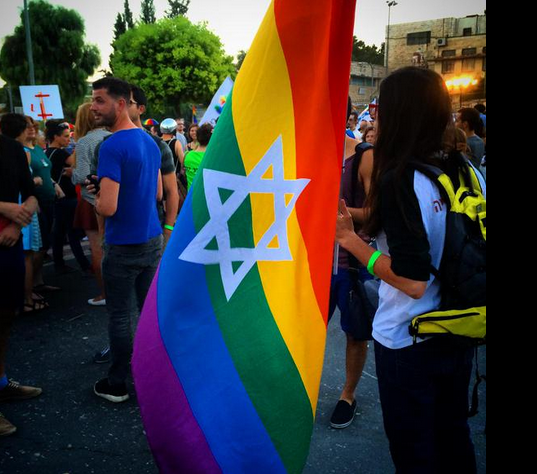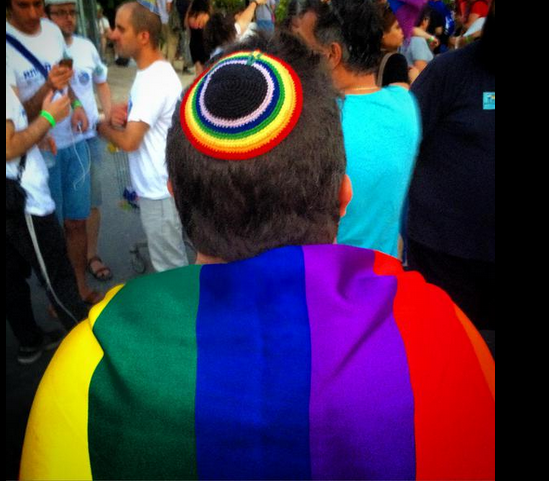
How Rainbow Jews Threaten a Black and White Haredi Worldview
In a smart and moving Facebook post later published in the Times of Israel, Jeremy Burton rightly reminds us that there are LGBTQ Jews being raised in the homophobic communities represented not only by Yishai Schlissel but also by those who think of a pride parade as an abomination march. Burton comes from such a community, which he has since left. Certainly leaving a community that does not honor you as being made in G-d’s image, an alternative prooftext for LGBTQ Jews, is and always should be one option. However, we must also collectively work for religious communities that do not force queer Jews to choose between intense love of Torah and love for their own queer selves. In 2001, Sandi Dubowski gave the Jewish world the gift of his documentary Trembling Before G-d, which illuminates the lives of those whose bodies and souls are at the intersection of queer and haredi. That film and novels such as Michael Lowenthal’s The Same Embrace (1998) and Judith Katz’s Running Fiercely Toward a High Thin Sound (1992) expose homophobia as a contemporary abomination that threatens klal Israel.
Yishai Schlissel literalized that threat last Thursday as he did in 2005 when he stabbed 3 people at the Jerusalem Gay Pride Parade. For that crime, he served a ten-year prison term, which ended quite recently. Within the last 2 weeks, Schlissel publicly talked about those “unclean people [who] want to continue to defile Jerusalem” and handed out leaflets urging “every Jew to expose himself to beatings and imprisonment and in my opinion to danger too, and join together to stop and abort this sacrilege.”
 Yishai Schlissel’s words indicate that he seeks to limit the very definition of Jew to those who believe that same-sex love and desire is an abomination. But photos that Yair Rosenberg shared on Twitter and credited to Avi Mayer challenge that definition of Jewishness in particular and instructive ways. A rainbow yarmulke and tallit, a rainbow flag with a Magen David at its center, and the participation of such groups as Bat Kol, the religious lesbian organization, affirm the intersection of queer identity and religious identity. That crossroads is, of course, a danger zone for haredi homophobes because it means that they can no longer claim to be the only essential and authentic form of Jewish and Judaic being. To haredi homophobes, rainbow Jews threaten a black and white worldview that seeks to falsely represent itself as that of “every Jew.”
Yishai Schlissel’s words indicate that he seeks to limit the very definition of Jew to those who believe that same-sex love and desire is an abomination. But photos that Yair Rosenberg shared on Twitter and credited to Avi Mayer challenge that definition of Jewishness in particular and instructive ways. A rainbow yarmulke and tallit, a rainbow flag with a Magen David at its center, and the participation of such groups as Bat Kol, the religious lesbian organization, affirm the intersection of queer identity and religious identity. That crossroads is, of course, a danger zone for haredi homophobes because it means that they can no longer claim to be the only essential and authentic form of Jewish and Judaic being. To haredi homophobes, rainbow Jews threaten a black and white worldview that seeks to falsely represent itself as that of “every Jew.”
The march continued after the stabbings, thus thwarting Yishai Schlissel’s desperate attempt to blot out queer Jewish pride in particular and Jewish diversity in general. Such a refusal to be cowed back into the closet should be inspiring to klal Israel. Next year in Jerusalem, may the Gay Pride Parade uphold the potential overlap between the religious and the secular realm: the foundational belief derived from Genesis that we are all made in G-d’s image and the foundational democratic belief that the basic rights of individuals must be zealously guarded by the body politic. Next year in Jerusalem, may the Pride Parade be unmarred by the abomination of homophobic hate and may all of Israel be strengthened rather than threatened by Jewish rainbows. And may the memory of Shira Banki be for a blessing.
Helene Meyers is Professor of English and McManis University Chair at Southwestern University. Most recently, she is the author of Identity Papers: Contemporary Narratives of American Jewishness. She is currently writing a book on Jewish American cinema.
One comment on “How Rainbow Jews Threaten a Black and White Haredi Worldview”
Comments are closed.




Oh, Lord, I hadn’t thought about Haredi gays. It reminds me of the rail thin black man who used to wobble through our neighborhood in miniskirt and high heels. After a few years of saying hello to Mr. Miniskirt, as I thought of him, I finally learned that he lived in a group home for mentally ill AID’s patients. What a rough community to be gay in, I thought.
A haredi community would be even tougher, particularly for men.
Can hate be a form of mental illness? Is it treatable at all? How, in a time when fanaticism seems on the rise among Muslim, Christian and Jew can we hope to transform these ultra-conservative communities into places that truly love and respect the “other” among them? Surely, the commandment: “Though Shalt Not Murder,” ranks far higher than the few sentences describing homosexuality, mixing fabrics, and yoking one animal to another as an abomination.
The same goes for those who set fire to a Palestinian home with people in it. In the name of Judaism. The very thought makes me ill.
http://sakkiselznick123.blogspot.com